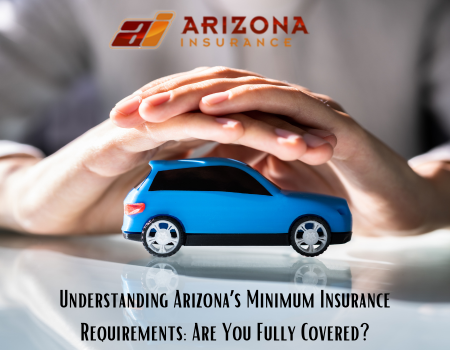Car insurance is not just a legal requirement in Arizona; it’s a vital safeguard for your financial well-being. Understanding the state’s minimum insurance requirements is crucial to ensure compliance with the law, but it’s equally important to know if those minimums are enough to protect you in case of an accident. Here’s a breakdown of Arizona’s minimum insurance laws and guidance on determining if you’re fully covered.
Arizona’s Minimum Insurance Requirements
 Arizona law requires all drivers to carry liability insurance, which covers damages or injuries you cause to others in an accident. The minimum insurance coverage limits includes:
Arizona law requires all drivers to carry liability insurance, which covers damages or injuries you cause to others in an accident. The minimum insurance coverage limits includes:
Bodily Injury Liability:
- $25,000 per person for injuries.
- $50,000 per accident for total injuries.
Property Damage Liability:
- $15,000 per accident for property damage.
- This is commonly referred to as 25/50/15 coverage. While it meets legal requirements, it’s essential to understand its limitations.
What Does Minimum Insurance Coverage Protect?
Liability insurance covers:
- Medical expenses for other drivers, passengers, or pedestrians injured in an accident you caused.
- Repair or replacement costs for property damaged in the accident, such as another vehicle or a fence.
However, minimum coverage does not protect:
- Your own medical bills.
- Repairs to your vehicle.
- Additional damages exceeding your policy limits.
For example, if you cause $30,000 in property damage, you’ll be personally responsible for the $15,000 exceeding your $15,000 limit.
Are Arizona’s Minimum Insurance Requirements Enough?
Arizona’s minimum requirements may provide basic protection, but they often fall short in serious accidents. Consider these scenarios:
- Medical Costs: A single hospital visit can easily exceed $25,000, especially if multiple people are injured.
- Property Damage: The average cost of a new car is over $40,000. If you total someone’s vehicle, $15,000 won’t cover the replacement cost.
These gaps can leave you financially vulnerable, as you’ll be responsible for any damages or injuries not covered by your policy.
Additional Coverage Options to Consider
To ensure you’re fully covered, consider adding the following types of insurance:
- Collision Coverage
- Covers repair or replacement costs for your vehicle, regardless of who is at fault.
- Especially valuable if you have a newer or financed car.
- Comprehensive Coverage
- Provides coverage for damages unrelated to collisions, including natural disasters, vandalism, or theft.
- Crucial for Arizona residents in areas prone to wildfires or monsoon storms.
- Uninsured/Underinsured Motorist Coverage (UM/UIM)
- Protects you if you’re involved in an accident with a driver who lacks sufficient insurance.
- Arizona has a relatively high percentage of uninsured drivers, making this coverage a smart investment.
- Medical Payments Coverage (MedPay)
- Pays for medical expenses for you and your passengers, no matter who is at fault.
- Can supplement health insurance in case of an accident.
- Increased Liability Limits
- Raising your liability limits to 50/100/50 or higher provides better protection against costly accidents.
Factors to Consider When Evaluating Your Coverage
- Your Assets: If you own a home, savings, or other significant assets, you’re at greater financial risk in a lawsuit. Higher liability limits can help protect your wealth.
- Your Driving Habits: Frequent long commutes or driving in high-traffic areas increase your risk of an accident. More robust coverage is a wise choice in these situations.
- Your Vehicle’s Value: If your car is worth more than a few thousand dollars, collision and comprehensive coverage can save you from significant out-of-pocket costs.
How to Choose the Right Policy
- Assess Your Needs: Evaluate your financial situation, driving habits, and risk factors.
- Get Multiple Quotes: Shop around for policies that offer the coverage you need at the best price.
- Consult an Agent: An insurance professional can help tailor a policy to your unique circumstances.
While Arizona’s minimum insurance requirements ensure legal compliance, they may not provide sufficient protection in a severe accident. By understanding your policy and exploring additional coverage options, you can safeguard yourself against financial hardship and enjoy peace of mind on the road. Investing in the right coverage today can save you from significant stress and expense in the future.
